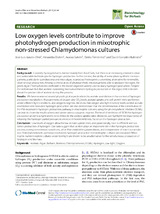Low oxygen levels contribute to improve photohydrogen production in mixotrophic non‑stressed Chlamydomonas cultures
Autor
Jurado Oller, José Luis
Dubini, Alexandra
Galván Cejudo, Aurora
Fernández Reyes, Emilio
González-Ballester, David
Editor
BioMed CentralFecha
2015Materia
AcetateAlgae
Biofuels
Biomass
Chlamydomonas
DCMU
Hydrogen
Low light
Oxygen
METS:
Mostrar el registro METSPREMIS:
Mostrar el registro PREMISMetadatos
Mostrar el registro completo del ítemResumen
Background: Currently, hydrogen fuel is derived mainly from fossil fuels, but there is an increasing interest in clean
and sustainable technologies for hydrogen production. In this context, the ability of some photosynthetic microorganisms,
particularly cyanobacteria and microalgae, to produce hydrogen is a promising alternative for renewable,
clean-energy production. Among a diverse array of photosynthetic microorganisms able to produce hydrogen, the
green algae Chlamydomonas reinhardtii is the model organism widely used to study hydrogen production. Despite
the well-known fact that acetate-containing medium enhances hydrogen production in this algae, little is known
about the precise role of acetate during this process.
Results: We have examined several physiological aspects related to acetate assimilation in the context of hydrogen
production metabolism. Measurements of oxygen and CO2 levels, acetate uptake, and cell growth were performed
under different light conditions, and oxygenic regimes. We show that oxygen and light intensity levels control acetate
assimilation and modulate hydrogen production. We also demonstrate that the determination of the contribution of
the PSII-dependent hydrogen production pathway in mixotrophic cultures, using the photosynthetic inhibitor DCMU,
can lead to dissimilar results when used under various oxygenic regimes. The level of inhibition of DCMU in hydrogen
production under low light seems to be linked to the acetate uptake rates. Moreover, we highlight the importance of
releasing the hydrogen partial pressure to avoid an inherent inhibitory factor on the hydrogen production.
Conclusion: Low levels of oxygen allow for low acetate uptake rates, and paradoxically, lead to efficient and sustained
production of hydrogen. Our data suggest that acetate plays an important role in the hydrogen production
process, during non-stressed conditions, other than establishing anaerobiosis, and independent of starch accumulation.
Potential metabolic pathways involved in hydrogen production in mixotrophic cultures are discussed. Mixotrophic
nutrient-replete cultures under low light are shown to be an alternative for the simultaneous production of
hydrogen and biomass.

